
THURSDAY, Feb. 2 (HealthDay News) —
Greater use of certain types of treatments for kids with sickle cell anemia may explain why black children’s risk of ischemic stroke dropped significantly between 1999 and 2007, new research finds.
The disparity in stroke-related deaths between black and white children also fell during that period.
Prior to 1998, black children were 74 percent more likely to die of ischemic stroke than white children.
The racial difference is attributed in part to higher rates of sickle cell anemia, a blood disorder that raises the risk of stroke, among black children, according to the study scheduled to be presented Thursday at the American Stroke Association meeting in New Orleans.
Then, in 1998, a major clinical trial found that treatments such as chronic (regularly scheduled) blood transfusions could dramatically lower the risk of stroke among kids with sickle cell anemia who were at high risk of stroke.
In the study, researchers reviewed death certificates for U.S. children and young adults under age 20 who died between 1998 and 2007.
Between 1999 and 2007, they found risk of ischemic stroke among black children fell significantly, although black children were still 27 percent more likely to have an ischemic stroke than white children.
Death records didn’t specify if children had sickle cell anemia, so researchers can’t say for sure that changes in sickle cell anemia treatment reduced the racial disparity.
“However, this was the only major change in pediatric stroke care in the past two decades, so we believe it was the most plausible explanation for our findings,” lead researcher Dr. Laura Lehman, a clinical fellow in the Cerebrovascular Disorders and Stroke Program in the neurology department at Children’s Hospital Boston, said in a stroke association news release.
She and her colleagues found that ischemic stroke (from blocked blood flow to the brain) accounted for 20 percent of 4,425 stroke deaths among U.S. children under age 20 between 1988 and 2007. Hemorrhagic stroke (caused by a burst blood vessel) accounted for 67 percent of those deaths.
Children with sickle cell anemia who have strokes tend to have ischemic strokes, while adults with sickle cell anemia tend to have hemorrhagic strokes, Lehman said.
In sickle cell anemia, normally round red blood cells become crescent-shaped, making it harder for blood to flow. The result is severe joint pain, tissue damage and complications such as stroke.
Ultrasound can be used to determine which kids with sickle cell are at high risk of stroke and should be treated with blood transfusions.
Because this study was presented at a medical meeting, the data and conclusions should be viewed as preliminary until published in a peer-reviewed journal.
More information
The March of Dimes has more about sickle cell disease.

